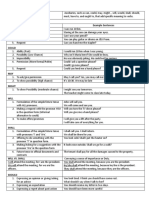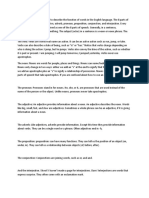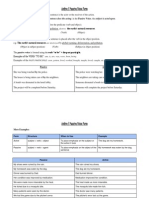Active and Passive Voice PDF
Active and Passive Voice PDF
Uploaded by
Tanupriya GoelCopyright:
Available Formats
Active and Passive Voice PDF
Active and Passive Voice PDF
Uploaded by
Tanupriya GoelOriginal Description:
Copyright
Available Formats
Share this document
Did you find this document useful?
Is this content inappropriate?
Copyright:
Available Formats
Active and Passive Voice PDF
Active and Passive Voice PDF
Uploaded by
Tanupriya GoelCopyright:
Available Formats
ACTIVE AND PASSIVE VOICE
A transitive verb (a verb which depends on an object) has two voices:
1. Active Voice
2. Passive Voice
Active Voice:
It indicates that the subject of the verb is the doer of the action or is active; e.g
We help our friends.
What is the action performed? helping
What is the subject of the verb? We
Who performs the action of helping? We
So in this sentence, the subject of the verb (We) also performs the action named in the verb (helping).
This sentence is said to be in the active voice.
Passive Voice:
It indicates that the subject of the verb is the receiver of the action or is passive; e.g
Our friends are helped by us.
What is the action performed? helping
What is the subject of the verb? Our friends
Does the subject of the verb (Our friends) also perform the action of helping? No. On the contrary, the
subject (Our friends) receive the action of helping. It is the object (us) who perform the action.
So in this sentence, the subject of the verb (Our friends) is the receiver of the action named in the verb
(helping). This sentence is said to be in the passive voice.
Rules to be followed while changing from Active to Passive:
1. The lion kills a goat. (active voice)
A goat is killed by the lion. (passive voice)
The passive object, a goat (which is being killed the receiver of action), becomes the subject
while the active subject, the lion (which is the doer of action), becomes the object. And we have
used the preposition by before it.
2. The above sentences are in Present Tense and in the second sentence, the subject (A goat) is
singular so is has been used and at the same time the third form (past participle form) of kills
(i.e killed) has been used with it. The third form of verb is used in the passive voice no matter
what the tense is.
3. We have to be careful about the use of personal pronouns.
I require some papers. (active) (subject form of the pronoun I)
Some papers are required by me. (passive) (object form of the pronoun I)
The teacher taught him. (active) (object form of the pronoun he)
He was taught by the teacher. (passive) (subject form of the pronoun he)
4. When the verb in the active voice has two objects, there are two forms in the passive voice.
My friend gave me a gift. (active) ( there are two objects me and a gift)
I was given a gift by my friend.
OR
A gift was given to me by my friend.
The first form is preferred.
5. The object or subject may be a long phrase instead of a single word. But while changing from
active to passive, the whole phrase will change its position.
The parents of all the scholars attended the prize distribution ceremony. (active)
The prize distribution ceremony was attended by the parents of all the scholars. (passive)
The earthquake demolished a large number of houses and buildings. (active)
A large number of houses and buildings were demolished by the earthquake. (passive)
6. If a verb is followed by any preposition in the active voice, the preposition is retained in the
passive voice.
She did not care for me.
I was not cared for by her.
They shouted at the naughty boy.
The naughty boy was shouted at by them.
7. Sometimes the subject is not important and we may omit it.
Somebody wants Aditi on the telephone.
Aditi is wanted on the telephone.
(We have omitted the words by somebody)
Simple Present Tense:
While changing from Active to Passive, Simple Present Tense takes the form:
Object + is / are / am + third form of verb + by + subject. E.g,
Geeta sings a song. (active)
A song is sung by Geeta. (passive)
He checks all items. (active)
All items are checked by him. (passive)
He teaches me. (active)
I am taught by him. (passive)
Simple Past Tense:
While changing from Active to Passive, Simple Past Tense takes the form:
Object + was / were + third form of verb + by + subject. E.g,
Heavy rains flooded the village. (active)
The village was flooded by heavy rains. (passive)
The driver applied the brakes. (active)
The brakes were applied by the driver. (passive)
Simple Future Tense:
While changing from Active to Passive, Simple Present Tense takes the form:
Object + will / shall + be + third form of verb + by + subject. E.g,
The loud noise will disturb the child. (active)
The child will be disturbed by the loud noise. (passive)
My mother will take me to Delhi. (active)
I shall be taken to Delhi by my mother. (passive)
Other Tenses:
TENSE ACTIVE VOICE PASSIVE VOICE
Simple Present Geeta sings a song. A song is sung by Geeta.
Present Continuous Geeta is singing a song A song is being sung by Geeta.
Present Perfect Geeta has sung a song. A song has been sung by Geeta.
Simple Past Geeta sang a song. A song was sung Geeta.
Past Continuous Geeta was singing a song. A song was being sung by Geeta.
Past Perfect Geeta had sung a song. A song had been sung by Geeta.
Simple future Geeta will sing a song. A song will be sung by Geeta.
Future Continuous Geeta will be singing a song. No Passive
Future Perfect Geeta will have sung a song. A song will have been sung by Geeta.
NOTE: Passive Voice is used while writing notices, newspaper reports, in process writing and in
advertisements.
You might also like
- List of Verbs, Nouns Adjectives & Adverbs - Build VocabularyDocument5 pagesList of Verbs, Nouns Adjectives & Adverbs - Build VocabularyAlya Nadhirah Abdul Wahid80% (10)
- Tense in Ndebele - Perfect TenseDocument1 pageTense in Ndebele - Perfect TenseNigel MaphosaNo ratings yet
- TensesDocument4 pagesTensesGoryan NikolenkoNo ratings yet
- Reduced ClauseDocument46 pagesReduced ClauseAdit Johan100% (1)
- MODAL VERBs CompiledDocument2 pagesMODAL VERBs CompiledMark Christian Sarical100% (1)
- O - L English - Model Paper 3Document10 pagesO - L English - Model Paper 3Dilka YasanthiNo ratings yet
- Simple Present Tense Worksheet 1Document21 pagesSimple Present Tense Worksheet 1SiddharthGuptaNo ratings yet
- PDF Noun Phrase CompressDocument4 pagesPDF Noun Phrase CompressAriezq AhmadNo ratings yet
- English Grammar A1 Level Possessive Case - English Grammar A1 Level PrintDocument2 pagesEnglish Grammar A1 Level Possessive Case - English Grammar A1 Level PrintBooks for languagesNo ratings yet
- Present PerfectDocument18 pagesPresent PerfectPopescu DanielaNo ratings yet
- Adj + Er (1-2 Syllabel) : Positive Comparative SuperlativeDocument2 pagesAdj + Er (1-2 Syllabel) : Positive Comparative SuperlativeNadira Fadhila HudaNo ratings yet
- Past Perfect Continuous TenseDocument3 pagesPast Perfect Continuous TensejeanNo ratings yet
- Active and Passive Voice AgusDocument14 pagesActive and Passive Voice AgusAgus SetiawanNo ratings yet
- Tag Question Lecture SheetDocument8 pagesTag Question Lecture SheetJewel AhmedNo ratings yet
- Countable and Uncountable NounsDocument12 pagesCountable and Uncountable NounsJalexi Esther Riveros Aguilar100% (1)
- Suffixal Homophones - Dr. Shadia Yousef BanjarDocument9 pagesSuffixal Homophones - Dr. Shadia Yousef BanjarDr. ShadiaNo ratings yet
- Complex Prepositions 1Document26 pagesComplex Prepositions 1Tika VirginiyaNo ratings yet
- Danny The Dog!: We Are Going To Have Help Learning About Adverbs FromDocument13 pagesDanny The Dog!: We Are Going To Have Help Learning About Adverbs FromCleo Abegail Palomado100% (1)
- The Eight Parts of SpeechDocument7 pagesThe Eight Parts of SpeechJasmin Binauhan Niegos-Trongco100% (1)
- NounsDocument13 pagesNounsGonzalo SardiñaNo ratings yet
- Active and Passive VoiceDocument3 pagesActive and Passive VoiceChristieUmang100% (1)
- Grammar 8 PDFDocument28 pagesGrammar 8 PDFgauravcomputer2015No ratings yet
- Present Perfect Simple Tense in EnglishDocument6 pagesPresent Perfect Simple Tense in EnglishAntoaneta StancuNo ratings yet
- The Verb Phrase: Be, Have, Do Can, Could, May, Might, Will, Shall, Would, Should, MustDocument3 pagesThe Verb Phrase: Be, Have, Do Can, Could, May, Might, Will, Shall, Would, Should, MustPetra BajacNo ratings yet
- Subject-Verb AgreementDocument26 pagesSubject-Verb AgreementYanitsa DimitrovaNo ratings yet
- 500 Common WordsDocument7 pages500 Common WordsgnyNo ratings yet
- The Passive Voice Gerunds Infinitives and Modal VerbsDocument9 pagesThe Passive Voice Gerunds Infinitives and Modal VerbsNurul Fatihah WahidNo ratings yet
- Vimshottari Mahadasha and AntardashasDocument1 pageVimshottari Mahadasha and AntardashasastroNo ratings yet
- Session 3 Verb and Verb PhraseDocument91 pagesSession 3 Verb and Verb PhraseMạnh Nguyễn ĐứcNo ratings yet
- Tion Sion - Word List and Sentences PDFDocument1 pageTion Sion - Word List and Sentences PDFKhim MurilloNo ratings yet
- Noun ClassesDocument24 pagesNoun ClassesMartyneJohnNo ratings yet
- Consonant ClustersDocument4 pagesConsonant ClustersStudentNo ratings yet
- ConcordDocument25 pagesConcordOnyx100% (2)
- What Is The Present ParticipleDocument9 pagesWhat Is The Present ParticipleAeo FikNo ratings yet
- Present Perfect ContinuousDocument8 pagesPresent Perfect ContinuousHajra RasmitaNo ratings yet
- Simple Form Simple Past Past Participle: Irregular Verbs: A Reference ListDocument2 pagesSimple Form Simple Past Past Participle: Irregular Verbs: A Reference ListDenir Roberto de OliveiraNo ratings yet
- Simple Present Tense: I Cook, You Cook, He Cooks.: Sentence PracticeDocument6 pagesSimple Present Tense: I Cook, You Cook, He Cooks.: Sentence PracticeEma Votson100% (1)
- Present Perfect TenseDocument9 pagesPresent Perfect TenseDost Jan100% (1)
- The Eight Parts of Speech - Final PPDocument65 pagesThe Eight Parts of Speech - Final PPapi-503217936No ratings yet
- English 1as1fDocument2 pagesEnglish 1as1famineNo ratings yet
- Passive VoiceDocument25 pagesPassive VoiceMinhhang LeNo ratings yet
- Verbs PrepositionsDocument4 pagesVerbs PrepositionsKarina RossiNo ratings yet
- Important Rules of Right Form of VerbDocument21 pagesImportant Rules of Right Form of Verbjosen98194No ratings yet
- Day - 34Document5 pagesDay - 34Yogita BhamareNo ratings yet
- English PRONOUNS Table ChartDocument1 pageEnglish PRONOUNS Table ChartPalash AhmedNo ratings yet
- Subject Verb AgreementDocument5 pagesSubject Verb Agreementpartz2004No ratings yet
- The GERUND AndcompoundnounDocument7 pagesThe GERUND AndcompoundnounJannice Coscolluela CanlasNo ratings yet
- Nominalisation: Nominalising The VerbsDocument3 pagesNominalisation: Nominalising The Verbsd100% (1)
- 78 VerbsDocument42 pages78 VerbsDiandra NovitaNo ratings yet
- Compound Words, Blends and Phrasal WordsDocument17 pagesCompound Words, Blends and Phrasal WordsZAMMI AKHDAN IKHSANI 120610100% (1)
- GerundDocument13 pagesGerundKristian Aji NugrohoNo ratings yet
- Gerunds: Active Passive Simple GERUND Perfect GERUNDDocument2 pagesGerunds: Active Passive Simple GERUND Perfect GERUNDMinja0% (1)
- Adjective PDFDocument3 pagesAdjective PDFAB Nav BhardwajNo ratings yet
- TENSE Forms - TablesDocument4 pagesTENSE Forms - TablesGheorghe RatiuNo ratings yet
- Relative Pronouns: Relative Pronoun Use ExampleDocument3 pagesRelative Pronouns: Relative Pronoun Use ExampleAnonymous yyzxrD3No ratings yet
- Noun RulesDocument12 pagesNoun RulesAsad HusainNo ratings yet
- 4 AdjectivesDocument19 pages4 Adjectivesapi-252190418No ratings yet
- Continuity of An Organism's LifeDocument31 pagesContinuity of An Organism's LifeNadia TaradhitaNo ratings yet
- Session 7Document7 pagesSession 7Katherine MondaNo ratings yet
- Handout On Grammar AspectsDocument12 pagesHandout On Grammar AspectsMoti GurmessaNo ratings yet
- Active and Passive Voice 082314Document9 pagesActive and Passive Voice 082314Raanya Raj NandaniNo ratings yet
- Change The VoiceDocument18 pagesChange The VoiceAshish AnandNo ratings yet
- Barter SystemDocument11 pagesBarter SystemTanupriya GoelNo ratings yet
- How Can I Use My Experience For Betterment of My City Oct 20th, 2016Document2 pagesHow Can I Use My Experience For Betterment of My City Oct 20th, 2016Tanupriya GoelNo ratings yet
- Powerpoint Skill Survey: 1 I Am Unable To Do This 2 I Can Do This With Help 3 I Can Do This!Document1 pagePowerpoint Skill Survey: 1 I Am Unable To Do This 2 I Can Do This With Help 3 I Can Do This!Tanupriya GoelNo ratings yet
- Verb Tenses Timeline ChartDocument2 pagesVerb Tenses Timeline ChartTanupriya GoelNo ratings yet
- 48.lamp Illumination Control System Using Sensor CircuitDocument4 pages48.lamp Illumination Control System Using Sensor CircuitTanupriya GoelNo ratings yet
- Features of Academic WritingDocument2 pagesFeatures of Academic WritingJem Bicol0% (1)
- Cae - Verbs + Infinitive or IngDocument7 pagesCae - Verbs + Infinitive or IngmithrandirNo ratings yet
- Modals Deduction VerbsDocument2 pagesModals Deduction VerbsKlaudia KołodziejskaNo ratings yet
- ConcordDocument23 pagesConcordtrdjydkytNo ratings yet
- Qur'aan Corpus (A Brief Summary On Arabic Grammar)Document74 pagesQur'aan Corpus (A Brief Summary On Arabic Grammar)Al Huda100% (1)
- Detailed SSC CGL Syllabus For Tier II Exam 2017: 5 Months Ago - 34 CommentsDocument13 pagesDetailed SSC CGL Syllabus For Tier II Exam 2017: 5 Months Ago - 34 Commentsanandamozhi sankarNo ratings yet
- English 10 Q2W1Document7 pagesEnglish 10 Q2W1Marco Antonio MatanguihanNo ratings yet
- English 5 - Q2 - PT - NewDocument11 pagesEnglish 5 - Q2 - PT - Newmariaviktoria.aquinoNo ratings yet
- The Sentence Pattern (ENG 513)Document54 pagesThe Sentence Pattern (ENG 513)Askin D. Villarias100% (1)
- Using The Correct TenseDocument5 pagesUsing The Correct TenseLula KotulovaNo ratings yet
- Base Two GrammarDocument41 pagesBase Two GrammarRashid KhanNo ratings yet
- 100 Tragic English MistakesDocument52 pages100 Tragic English MistakesauradariaNo ratings yet
- UNIT 6 VocabDocument8 pagesUNIT 6 Vocabdungnhm25062005No ratings yet
- English 1st Semester BSN MCQS, Abdullah Danish Dani Meh WritesDocument18 pagesEnglish 1st Semester BSN MCQS, Abdullah Danish Dani Meh Writeskhan alamNo ratings yet
- Passive VoiceDocument3 pagesPassive VoicerachidswimmerNo ratings yet
- English Exam Earth DayDocument2 pagesEnglish Exam Earth DayAissamNo ratings yet
- The Last Leaf ReviewDocument10 pagesThe Last Leaf ReviewRowena C. LasNo ratings yet
- Key Grammar PointsDocument13 pagesKey Grammar PointsJason BatsonNo ratings yet
- Phrasal Verbs PresentationDocument26 pagesPhrasal Verbs PresentationJose MorcilloNo ratings yet
- 41 U1 WRI LinkingDocument4 pages41 U1 WRI LinkingLucía AcostaNo ratings yet
- PartsofspeechwebquestDocument6 pagesPartsofspeechwebquestapi-282034340100% (1)
- BBC British Council Teaching English - Literature - Storytelling - Benefits and TipsDocument99 pagesBBC British Council Teaching English - Literature - Storytelling - Benefits and TipsRuxandra Maria StoicaNo ratings yet
- Tired of Not Getting Band 4 On TKT?Document118 pagesTired of Not Getting Band 4 On TKT?Dario van KrauserNo ratings yet
- Verb Tenses - NewDocument16 pagesVerb Tenses - NewSai AmruthaNo ratings yet
- Ingles Modulo2 - GeneralDocument1,699 pagesIngles Modulo2 - GeneralLu PeñaNo ratings yet
- Business Telephoning in Practice PDFDocument176 pagesBusiness Telephoning in Practice PDFFrancesca MortaraNo ratings yet
- TOEFL Prep 1 StructureDocument133 pagesTOEFL Prep 1 StructureAnonymous 42HmqEhY3No ratings yet
- Theoretical Grammar 3Document18 pagesTheoretical Grammar 3Kokebayeva NazymNo ratings yet






























































































